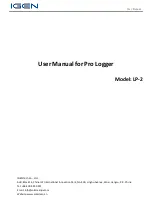
Section 8. Operation
383
For most applications, the advanced techniques of static and dynamic VSPECT
measurements are preferred.
8.1.5 Period Averaging — Details
Related Topics:
• Period Average Measurements — Specifications
•
Period Average Measurements — Overview
(p. 73)
•
Period Average Measurements — Details
(p. 383)
The CR800 can measure the period of a signal on a
SE
terminal. The specified
number of cycles is timed with a resolution of 136 ns, making the resolution of
the period measurement 136 ns divided by the number of cycles chosen.
The measurement is performed as follows: low-level signals are amplified prior to
a voltage comparator. The internal voltage comparator is referenced to the
programmed threshold. The threshold parameter allows referencing the internal
voltage comparator to voltages other than 0 V. For example, a threshold of 2500
mV allows a 0 to 5 Vdc digital signal to be sensed by the internal comparator
without the need for additional input conditioning circuitry. The threshold allows
direct connection of standard digital signals, but it is not recommended for small-
amplitude sensor signals.
For sensor amplitudes less than 20 mV peak-to-peak, a dc blocking capacitor is
recommended to center the signal at CR800 ground (threshold = 0). Figure
Input
Conditioning Circuit for Period Averaging
(p. 384)
shows an example circuit.
A threshold other than zero results in offset voltage drift, limited accuracy
(≈
±10
mV
),
and limited resolution (≈1.2 mV).
The minimum pulse-width requirements increase (maximum frequency decreases)
with increasing gain. Signals larger than the specified maximum for a range will
saturate the gain stages and prevent operation up to the maximum specified
frequency. As shown in the schematics, back-to-back diodes are recommended
to limit large amplitude signals to within the input signal ranges.
Caution
Noisy signals with slow transitions through the voltage threshold
have the potential for extra counts around the comparator switch point. A
voltage comparator with 20 mV of hysteresis follows the voltage gain
stages. The effective input-referred hysteresis equals 20 mV divided by
the selected voltage gain. The effective input referred hysteresis on the
±
25 mV range is 2 mV; consequently, 2 mV of noise on the input signal
could cause extraneous counts. For best results, select the largest input
range (smallest gain) that meets the minimum input signal requirements.
Summary of Contents for CR800 Series
Page 2: ......
Page 4: ......
Page 6: ......
Page 32: ......
Page 34: ......
Page 54: ......
Page 92: ......
Page 310: ......
Page 446: ...Section 8 Operation 446 8 11 2 Data Display FIGURE 100 CR1000KD Displaying Data ...
Page 448: ...Section 8 Operation 448 FIGURE 102 CR1000KD Real Time Custom ...
Page 449: ...Section 8 Operation 449 8 11 2 3 Final Storage Data FIGURE 103 CR1000KD Final Storage Data ...
Page 450: ...Section 8 Operation 450 8 11 3 Run Stop Program FIGURE 104 CR1000KD Run Stop Program ...
Page 452: ...Section 8 Operation 452 FIGURE 106 CR1000KD File Edit ...
Page 456: ......
Page 462: ......
Page 523: ...Section 11 Glossary 523 FIGURE 116 Relationships of Accuracy Precision and Resolution ...
Page 524: ......
Page 526: ......
Page 556: ......
Page 558: ......
Page 560: ......
Page 597: ......














































